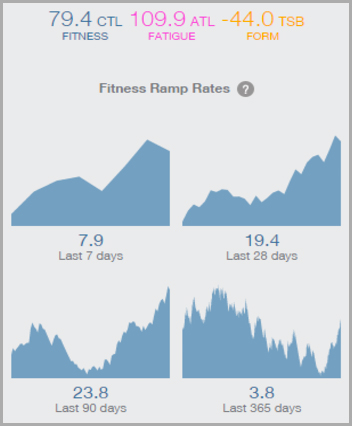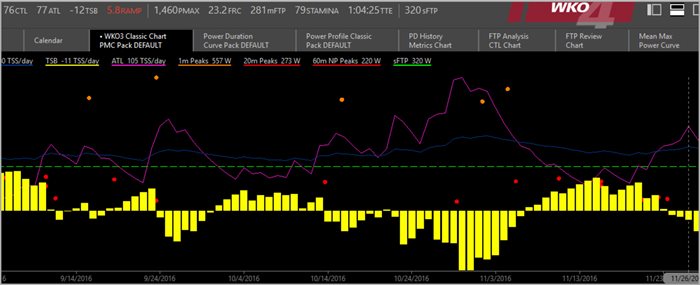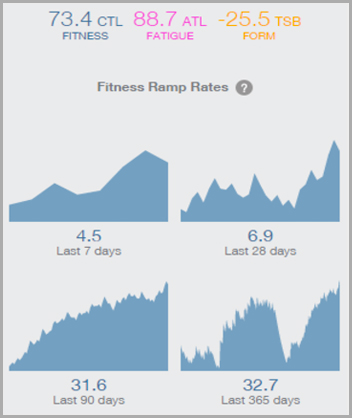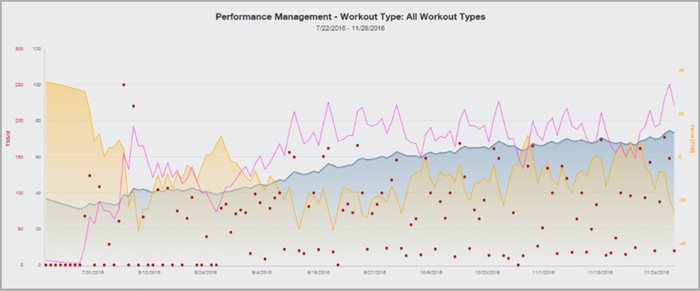TrainingPeaks not so recently released WKO4. Many coaches’ minds were blown upon gazing at a dozen or so new ways of measuring our cycling metrics and analyzing our athletes’ efforts and fatigue. One of these metrics is “ramp rate.” This metric is not any more or less important than Time to Exhaustion (TTE), Stamina or Functional Reserve Capacity (FRC) but it has a large importance in tracking Chronic Training Load (CTL), Training Stress Score® (TSS®), and fatigue and, as this is the time of year for increased training load, and therefore increased ramp rate, this fatigue measure has heightened seasonal significance. If you are unfamiliar with these terms check out the TrainingPeaks glossary of terms page.
To define ramp rate we need to know what Training Stress Score (TSS) and Chronic Training Load (CTL) are. TSS is a stress score based on the fatigue a certain effort or ride will place on your body. TSS is defined by the Intensity Factor®, which is Normalized Power® as a fraction of threshold power, and duration of the effort or day’s ride. These TSS scores are added up day-by-day to make the average daily TSS, or Chronic Training Load.
So now that we have that under our belts, what is ramp rate? Defined by TrainingPeaks, “The ramp rate, expressed in TSS/day, shows daily rate of change (both positive or negative) that your CTL changes.”
For Premium athletes on TrainingPeaks, under your Home tab on the web or in the Fitness Report in the mobile app, ramp rate is expressed in 7, 28, 90, and 365 day periods as seen below.

In WKO4 (below) the ramp rate is located on the very top in the Hero Bar. You can set your ramp rate constants and when the red “warning” color shows up depending on the “normal” client fatigue for each client.

When comparing WKO4 and TrainingPeaks (TP), make sure you are comparing the same data in both programs. You need all workouts to be in WKO from TP. Make sure your athlete’s history is correct or matching that on TP. WKO is based on the Set FTP (sFTP) not Modeled FTP (mFTP). TSS is calculated from sFTP so if there’s different data and different athlete history then the ramp rate will not be the same as TSS per day created CTL and ramp rate.
Since we know that with fatigue comes fitness, we expect to have a positive ramp rate to increase fitness. That’s pretty much the only solid assumption to the most frequent question of, “What should my ramp rate be?” Ramp rate may not be positive 100 percent of the time. We expect to see negative ramp rates during longer rest periods. Other than that, each athlete can expect to have different ramp rates.
The TP ramp rate example above is from a client in Colorado that had very mild fall weather, which drove us to give him a large block of training. As you can imagine with such a large ramp rate and jump in CTL, he is pretty tired right now but, with some recovery, he will come back a monster. Another factor is that, toward the end of the summer, this athlete’s race season ended a bit early. He had fewer days with high TSS and thus lost TSS per day, resulting in a negative ramp rate, while losing CTL or losing average TSS per day. As he started this ramp rate at a lower TSS per day, he can have a steeper short term ramp rate.
The main point is that every rider’s ramp rate is a function of how they are gaining fatigue in that moment where their CTL started off and that rider’s ability to hold fatigue. You will also see a large ramp rate with someone who is new to power and starts at zero TSS per day. Obviously every day with a TSS score after 0 will have a positive ramp rate. Here is a client who just got a power meter in August. We expect to see a large ramp rate until he gets to a point where an increase in CTL is not raising his average CTL per day making his ramp rate so steep.

The opposite example to the “new to power” athlete is the athlete that has years of power data. This specific long-term power athlete never really loses CTL year to year. This rider is still being built with specific workouts at different time per year for their events and goals but holding a constant Chronic Training Load will make an increased ramp rate or a jump in CTL a challenge. On one hand it seems like diminishing returns. You will have elite riders that carry CTL see less gains in general, but even riders newer to cycling that are seeing larger gains will have a hard time increasing their ramp rate if they carry a large CTL for an entire year. These different comparisons should key you into what type of rider they are, how they carry fatigue and then how much resting to building they should be doing.


This athlete has a set amount of time to train. He can’t get a huge ramp rate but, in the same breath, he does not need large rest periods. After three years of data, I know from ramp rate when we are really pushing versus when we are sustainable. For this athlete, the difference in ramp rate is very small between overreaching and rested. This is another example of how each athlete needs customized training and tracking.
There are a few things to watch out for that may skew ramp rate. We need good data and good Functional Threshold Power (FTP) settings. Beside the fact that having wrong or unset FTP history in WKO4 will make everything incorrect, it will also skew TSS and everything calculated downstream. If the FTP is set too high, your IF will read low for the day. Since TSS per day makes CTL, an FTP estimation too high will skew TSS down, CTL down, and then ramp rate will be low. This will drive you as a coach to push the athlete to greater fatigue, maybe even overtraining just from analyzing bad data. As coaches we need good data, accurate power meters, and accurate FTP or field testing data to make everything downstream correct. Since 100-percent correct data does not happen, a good coach needs to be able to pick out right and wrong data and use the tools at hand to find bad patches and deal with them accordingly. Sometimes it takes hours to pinpoint a bad file with major spikes or bad calibration but that file has to be corrected if we want to trust overall metrics computed by WKO4 and TrainingPeaks.
One other thing that catches people and coaches off guard is the idea of accumulating fatigue from outside factors. If, for example, the mental fatigue that this election caused on my brain was trackable in a TrainingPeaks metric, that was put into CTL, my ramp rate would be through the roof. There’s no way to track some things but they should be tracked in some way in TP or on the side to make sure the rider is not overreaching despite ramp rate being low or stagnant. Some examples are running workouts, non-power but HR and TSS trackable workouts, and all the workouts that create fatigue like hiking or snowshoeing.
Once everything is correct we can use ramp rate as one of the new metrics for fatigue tracking, tapers, overreaching prevention and just solid, fundamental data-driven coaching.
Learn more about WKO4 features and how-to videos or try it free for 14 days.


